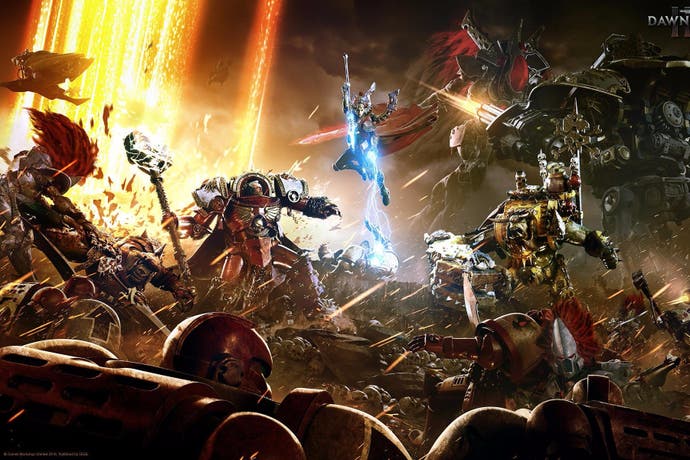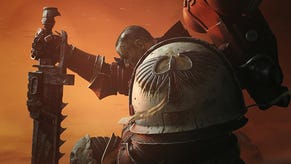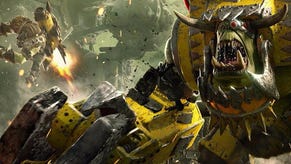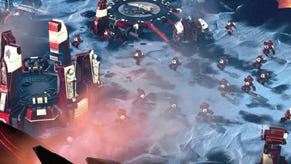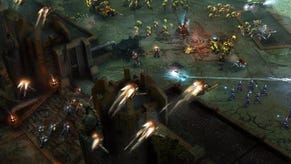Dawn of War 3 is brutal, beautiful, and inconsistently brilliant
Hammer time.
Editor's note: this is an early verdict on Dawn of War 3 based on a full campaign playthrough and a couple of hours in multiplayer. Watch out for our final thoughts after release, once we've had a chance to see how the online holds up in the wilds.
Twelve missions deep into Dawn of War 3's campaign, I'm getting a little tense. It's been an enjoyable, if predictable ride so far; the story's a schlocky, quintessentially 40k epic of stoicism, but all pretty steady-as-she-goes as far as mission design.
Now, though, things are hotting up. I've breezed through the previous mashups of survive-kill-repeat, but this battle's not going quite so smoothly. No sooner had I guided Gabriel Angelos to the rescue of his scattered, ever-vigilant brothers than they died, bellows of "servitude!" and "xenos!" and "honor!" making little difference to what must have been hundreds of onrushing Orks.
After taking out a giant Ork tractor beam, the purpose of which I can't reveal (or really understand, but then, that's the fun of the Orks), all I have to do is hold out until extraction. Typical RTS stuff. But at this point I have just one Dreadnought left, a few Devastator Marines, my elites - Angelos, alongside his friends the Librarian Jonah Orion and Chaplain Diomedes - and, well that's about it.
The Dreadnought finishes dismantling the tractor beam, but then down goes Angelos - I'd left him a little overexposed, having gone after a backline of Shoota Boys - and now I'm in real trouble. Swarms of Ork cannon fodder plow into the heavy cover my Devastators were using and with that, the cathartic churn of bolter-fire winds down. I lay out a quick combo from the Librarian, squelching a good three squads of greenskins with a shock of lightning and sealing several others within a temporary walled arena for the Dreadnought to do the rest. But Diomedes is caught outside the wall - I had no choice! - and a few valiant thunks of the hammer later, down he goes. The Librarian follows, and now it's just the trusty Dreadnought. He's served me well, that Dreadnought. I almost want to wipe away a tear as he turns another four xenos to red mush with a resplendent Slam, slugging away in the face of the inevitable. It's another twenty seconds until Angelos can redeploy, and our enemies are all around us.
Sure enough the Dreadnought implodes, and that's Mission Failed. A good forty-five minutes down the drain at this point - there are no checkpoints, astonishingly, even in missions much longer than this. But then, that's three quarters of an hour I'd gladly relive.
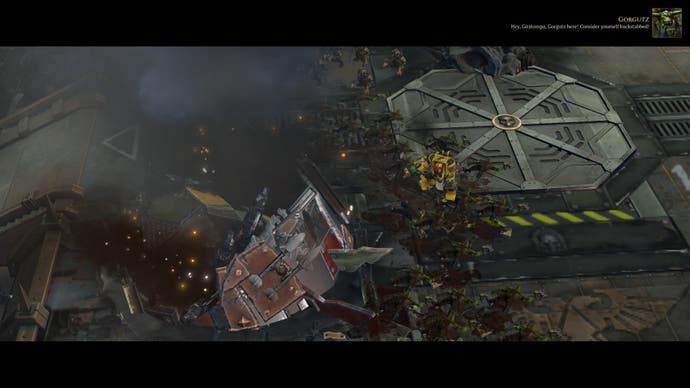
This, for me, is Dawn of War 3 at its best, at least so far. I'm certain the people at Relic have their own ideas as to what DoW 3's high points are - the scale of the combat is probably the stand-out feature at a glance. But whilst I'll never really tire of seeing a towering Wraithknight powerslide on its knees through tiny squealing Orks - half rockstar, half drunk dad kicking over your LEGO - it's the little things that really grab me, the horribly difficult multitasking and micromanagement that is, of course, an essential part of any RTS.
Down here in the genre's trenches, DoW3 separates itself from the pack. It's equal parts infuriating and enthralling, thanks to one of the most talked-about new modifications to the formula: an active ability system ripped from the strategy relative everyone loves to hate, the MOBA.
On the surface, it's really just a few more active abilities for certain units, mapped to the QWER buttons in mimicry of how MOBA set up your abilities. It's a painfully simple change, but this may be one of the best evolutionary tweaks to real time strategy that we've seen in some time, because whilst micromanagement is already pretty much everything in real time strategy, here it's ramped up to even greater importance.
Campaign missions - take my failed survival attempt as an example - often scatter the map with various optional sub-objectives, from rescuing isolated Marines to seeking out collectibles or adding new followers to your cause. They aren't handled in hugely inventive ways - it's normally a case of "go to the smaller objective marker on your map and kill something" - but having to split your troops between multiple fronts makes a considerable difference.
Active abilities are also doled out more generously than you might have been led to believe, with near enough every unit in the game holding at least one. Whilst the Elites have been put front and centre in much of DoW3's messaging and, indeed, the story, they aren't much more important in-game than the toughest units from previous entries, save for the absolute top-tier, late-game walkers. Terminators are Terminators. It's just that for them to work as effectively as you'd expect, you might need to pay a little more active attention.
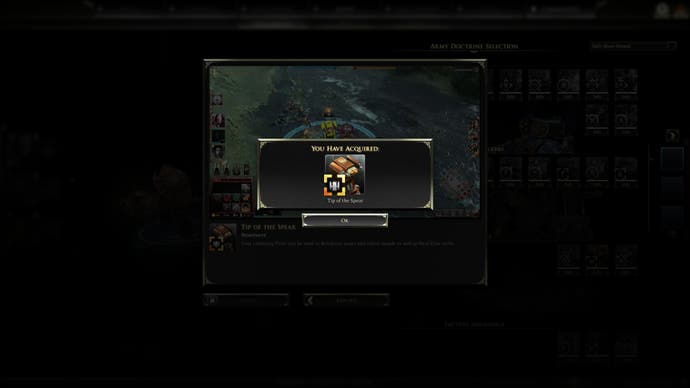
More attention is required of you before you get into a game, too. Before each campaign mission and multiplayer game you'll need to select up to three Elite units, and three Doctrines - Dawn of War's take on the pre-match Intel Bulletins of Relic's own Company of Heroes 2, or dare I say it, League of Legends' Runes and Masteries. These are modifiers, unlocked by spending Skulls, an in-game currency awarded for completing campaign missions or online matches (Dawn of War's extensive army painter also returns, so you can tailor the look of your units).
But where some versions of this concept don't make much impact - a half percent accuracy increase here or there - Doctrines grant opportunities for a noticeable shift in playstyle. You can apply a Doctrine that lets Orks heal by looting scrap, for example, or go with Listening Posts that reinforce your Space Marine troops on the front line. They can also unlock both passive and active abilities for some units that otherwise lack them. The variety there, particularly when coupled with choosing Elites - do I go early game rush with some quick-to-unlock assassins, or late game tech with a huge walker unit and some high-cost soldiers? - and on top of being restricted to three Doctrines at a time, represents another welcome layer of strategy and control.
As I spend more time in the multiplayer in the coming days, I'm hoping the pre-game decision-making will give rise to a lively, evolving meta after launch. But there's also a handful of things I'd like to see improved on.
The most prominent, albeit nebulous, of those is resource flow. Dawn of War 3 centres on the same two resources as the original, Requisition and Power, plus new Elite Points. Relic has toyed with that balance for some time now, not just within their 40k franchise, so it's disappointing to find things a little out of tune here. I've often found myself with huge sums of spare Requisition and not a shred of Power, despite upgrading my captured points wherever possible.
More time is needed to play around with builds and opposition in multiplayer before really addressing that side of things, of course, but then, I'm largely drawing from my experiences in single-player. Resource points have different kinds of output - some you can build two Power generators on, for example, others none at all - and these aren't always logically distributed in campaign missions, which don't always give you a base at all. I'm sure there's a reason for it, but I just cannot fathom why I'd be handed a fully-functioning base in a mission, only to have my ability to produce units from it totally kneecapped.
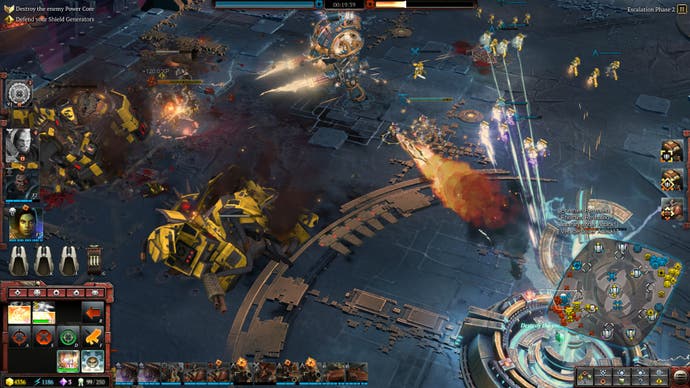
There are, likewise, a couple of things that Relic seem to have glossed over as regards their forays into neighbouring genres. For one, there's a curious sluggishness in response to your inputs in DoW3, with units often waiting half a second before moving or changing course. Bearing in mind Relic's justification for removing the fan-loved death animations of the original DoW - a necessity, the developer has said, to ensure absolute control in competitive matches - having such painfully slow responses in a world where eSports players move from one coast of America to the other in search of 8 millisecond ping is a real blemish.
I have other, minor gripes - years of League of Legends have made me alarmingly snobbish about tooltip clarity, for one thing ("Land Speeders fight harder when they are behind enemy lines" could mean anything!) - but I'll be reserving judgment on these and more important issues like the AI, balancing and the general flow of online matches until our full review.
For now though, there are signs of serious promise. Bringing it back to that button-mapping for just another second, this feels like the RTS equivalent of the moment everyone sat down and decided that controllers have two analog sticks and the jump button goes where PlayStation put the X. What's more, DoW3 has more going on than both previous games combined when it comes to scale, tone and the straight-up phwoarr-factor of battle. Whether or not those brilliant highs are undermined by a couple of clumsily missed marks will become clear enough soon.
